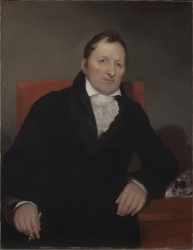
“Eli Whitney,” portrait of the inventor, oil on canvas, by the American painter Samuel F. B. Morse. 35 7/8 in. x 27 3/4 in. Courtesy of the Yale University Art Gallery, Yale University, New Haven, Conn.
On March 14, 1794, Eli Whitney received a patent for the machine known as the Cotton Gin. Here is a short video about the Connecticut-born inventor’s most famous “invention,” the Cotton Gin. This was created as my first contribution to Ted-Ed: “Lessons Worth Sharing.”
This portrait of the inventor is by another inventor– Samuel F.B. Morse who was a well-known painter and art teacher before he gained fame for the development of the telegraph and the Morse Code.
The cotton gin changed history for good and bad. By allowing one field hand to do the work of 10, it powered a new industry that brought wealth and power to the American South — but, tragically, it also multiplied and prolonged the use of slave labor. In this video, I discuss innovation, while warning of unintended consequences.
Eli Whitney died in New Haven, Connecticut on January 8, 1825. You can learn more about Whitney and his inventions at the Eli Whitney Museum and Workshop.